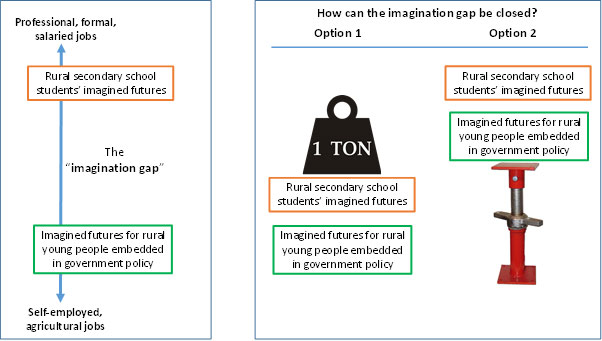To increase the work opportunities available to rural young people in Africa, government policy and development programmes tend to highlight two potential pathways:
- Agriculture, and the most common line is that taken by Karen Brooks and her colleagues at the International Food Policy Research Institute (IFPRI) when they assert that ‘African agriculture can absorb large numbers of new job seekers and offer meaningful work with public and private benefits’
- Entrepreneurship, and here the suggestion is that with a more vibrant entrepreneurial culture, new skills and access to capital, young people should be able create their own jobs. In August 2014 the Ghana government established the Youth Entrepreneurship Support (YES) Fund (Ghana Cedi 10 million; US$ 3 million), to ‘help Ghana’s young and innovative population turn great ideas into thriving business enterprises’. This is but one example of the growing ‘turn to entrepreneurship’.
For many policy makers and development professionals, the combination of agriculture and entrepreneurship is the sweet spot for employment creation for young people in rural Africa. To put it another way, the imagined futures for rural young people that are embedded in government policy and much development programming are entrepreneurial, self-employed, rural and agricultural.
An imagined future
How do these imagined futures compare with those that rural secondary school students imagine for themselves? In a recent study we worked with 38 students (18 male, 20 female) in two secondary schools – one in Ashanti Region and the other in Northern Region. We used Q Methodology to explore their perspectives concerning two questions:
- What is a desirable job?
- What makes a job desirable?
More information about the methodology and results can be found in the recent Future Agricultures Consortium Working Paper.
Two main findings are relevant.
Firstly, the dominant perspectives of the students consistently suggested that desirable jobs were formal, salaried and professional. There was only the slightest hint that they imagined themselves in the future as entrepreneurs; and within the dominant perspectives there was little positive enthusiasm for farming as a job.
Second, it was striking how consistently helping others or making a contribution to society or the nation were seen as making a job desirable. While there were clear differences in emphasis in relation to the importance of, for example, money, recognition, respect and personal development, in both schools the idea of making a contribution permeated students’ sense of what made a job desirable.

Pointing to the “imagination gap”
We suggest that these findings point to an important “imagination gap” (see left hand panel of the figure below) – between the imagined employment futures for rural young people that are embedded in policy and development programming (entrepreneurial, self-employed and agricultural), and the employment futures imagined by the secondary students themselves (professional, formal and salaried jobs). The existence of this gap greatly increases the probability of implementation failure in relation to youth-oriented employment policy and programmes.
How can the gap be closed?
To reduce the probability of implementation failure the imagination gap must be closed.
There are two options:
- Bring the imagined futures of the students closer to the ideal of policymakers by, for example, convincing the young people of the need to be practical and realistic, that there are opportunities in agriculture, and that life in the city is not always rosy.
- Policymakers and development professional should reimagine the future – and specifically the nature of the economy and society, and the role of the state vis-à-vis young people. Such a reimagining would provide an opportunity to think big and to be ambitious, and allow the imagined future embedded in policy to move closer to and align with the futures that students imagine for themselves.
In this light, we argue that the change has to come from policymakers and development professionals. At present, the current approach to tackle the youth employment problem in Africa embodies our first suggestion. That is, that students need to change and lower their sights to fit with the vision of policymakers and development professionals. However, there is no doubt in our minds that the better way to close the “imagination gap” requires policymakers and development professionals to match the optimism, idealism and ambition of the young people they are seeking to support.
